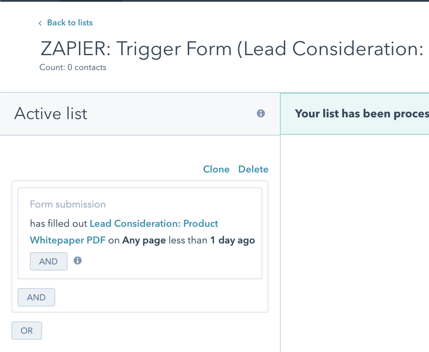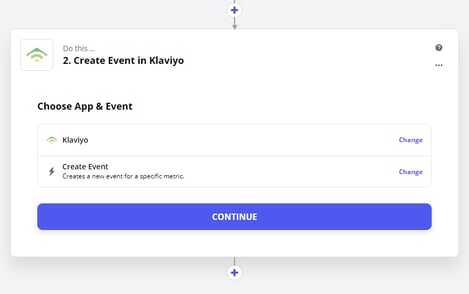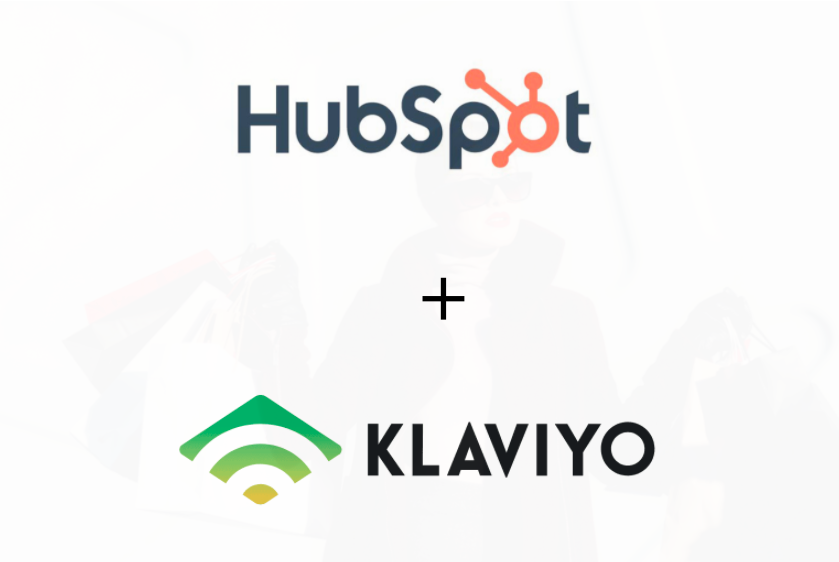HubSpot might not like this post, but I think it’s an important option to lay out. Brands with a B2B or consumer sales team will have a better long-term fit on HubSpot. But if a 1-year Marketing Hub contract is too big a jump right now, how could you use both Klaviyo for email marketing AND HubSpot for sales?
I still believe this year is the best possible time for brands to move online into ecommerce and forge their way through digital marketing. Again, Klaviyo does not have any built in sales team tools so it's not even worth recommending as the sole option if your revenues rely on sales reps.
But there's an opportunity to blend the two tools in some ecommerce businesses. You have the option of committing to a purchase of 100% HubSpot or building an alternative strategy using HubSpot for sales and Klaviyo for email marketing/automation.
Quick Math and Long-Term Goals
Here's some past customer types I've worked with where using both Klaviyo AND HubSpot/Unific would make sense, if they were starting the transition into digital ecommerce:
- A B2C home appliance brand with an AOV of $200 USD where 60% of their orders (not necessarily sales revenue) are initiated through chat or message correspondence
- A high-end apparel brand where 30% of their business comes Wholesale and all of those wholesale/reseller transactions are made through the shopping cart
- A consumer health supplements brand where 20% of revenues are closed only after talking with a rep, and all customers are assigned a follow-up consultant for ongoing help
Without factoring in discounts, a list of 30,000 marketing/newsletter contacts with 5 dedicated sales reps would cost:
- HubSpot, Only: $2,650/mo ($31.8K/yr): $2,250/mo for Marketing Hub Pro + $400/mo for Sales Hub Pro
- HubSpot+Klaviyo: $1,061.25/mo ($12.7K/yr): $500/mo for Klaviyo + $100/mo for Marketing Hub Starter for form customization + $400/mo for Sales Hub Pro + $61.25/mo (depending on Task volume) for Zapier Professional to sync/replay key sales data
- A brand would save $19.1K/yr using HubSpot+Klaviyo, without including platform onboarding costs
Here's the HubSpot pricing and Klaviyo pricing pages so you could do the math with your own business.
HubSpot also is releasing a concept of designated "Marketing Contacts", which solves a huge pain point of paying for every contact. Till now Ecommerce brands would regularly need to purge their HubSpot account for contact limits, but going forward HubSpot customers will get free storage on CRM contacts (up to 1 million) that aren't actively designated for marketing emails or ads.
Although this may save you money, you need to weigh this against the impact on your sales reps' output volume versus having everything in one place. If this is the choice you make for the next year, be sure that this risk minimization isn't also costing you growth over the next year.
Major Downsides of Using Two Systems
Using both Klaviyo and HubSpot can be a short-term way to keep your costs down while you grow and navigate this new normal, but until you can financially commit to HubSpot-only you'll have to contend with practical downsides:
- Your sales team won't have all they need in one place: Any marketing email or subscription engagement will require the rep to login to Klaviyo and switch browser tabs
- Email automation based on sales activity is more complicated: If a rep needs to suspend or add marketing emails based on sales interactions (including spam or unsubscribe complaints), this will have to be done manually in Klaviyo or require one-way Zapier automations
- Triggering Klaviyo automation for each HubSpot form submissions via Zapier: I'll cover more of these practicalities, below.
Flat out, I do NOT recommend this plan if your ecommerce business is a pure B2B play. If you have no consumer element to your business at all, then I believe you'll be creating more headaches for your sales teams than the cost savings are worth and you should just jump straight to full HubSpot.
Webform "System of Record"
Handling webform data is the most difficult part of using both systems, because webforms are a "point of origin" for a CRM.
Klaviyo and HubSpot/Unific can simultaneously sync shopping cart transactions without a problem because that data originates outside the marketing platform, but splitting that webform job across two systems becomes really impractical if not managed carefully.
Here's my advice for how to manage your tech stack and make your webform "system of record" as simple as possible to minimize data visibility problems:
- Do NOT send any newsletter/marketing broadcasts out of HubSpot, even if it's included in your pricing tier: Keep all marketing nurture emails in Klaviyo, which means that all marketing spam complaints/unsubscribes can be exclusively managed in Klaviyo.
- Keep all general Newsletter signup webforms and management inside of Klaviyo: Since all email marketing will be done through Klaviyo, collect all generalized email signups through Klaviyo or native shopping cart forms (even though you lose out on HubSpot's powerful form tracking)
- Do not connect 3rd party consumer marketing tools (popups, rewards programs, etc) to HubSpot: Again, since all email automation and communication will be done in Klaviyo, adding this data into HubSpot will only add mess. If this becomes an inhibitor to sales team visibility, some 3rd party tools (like Smile.io) have native HubSpot integrations, but these should be dual-synced with Klaviyo and treat the data in HubSpot as read-only for the sake of sales team awareness or segmentation
- Build all Wholesale/B2B-specific inquiry forms in HubSpot: I've only rarely worked with brands who actually have a Wholesale-specific newsletter, so there's a good chance that you never need a practical reason to get these contacts' marketing subscription data back into Klaviyo. Much of the next actions and nurturing you need to do can be done via emails, phone calls, and meetings with a sales rep, so it's often simpler that this entire inqury and followup process stay in HubSpot. If needed, you can create a simple Subscriber List zap, which I'll describe below.
- Use HubSpot for webforms that are strategically connected to landing pages or next actions for your traffic generation: This is the Inbound methodology where HubSpot's functionality will really shine over time, so you'll want to take the extra effort to build that form in HubSpot then Zap it back to Klaviyo in a Subscriber List. (Even if the contact has unsubscribed from marketing in Klaviyo, it's reasonable to continue sending them confirmation emails of webforms they fill out from HubSpot) You can deliver the signup PDF or whatever requested content from a single HubSpot marketing email, but then make sure to send all additional nurturing emails out of Klaviyo.
HubSpot Tech Stack Game Plan
With the background of keeping all email marketing within Klaviyo, here's a high-level overview of how I'd set up HubSpot for your sales team:
- Use Unific for the Ecommerce Integration: HubSpot's native integration is a good place to start, but it lacks some data robustness compared to the 100+ contact fields we natively sync. If you're going to use two systems, minimize that struggle of data visibility by getting as much usable Contact-level cart data inside of HubSpot as possible. (We're also free up to 1000 orders per month)
- Get HubSpot's Sales Hub Pro for your entire team: Even if you don't have enough sales reps for the 5 minimum licenses on Sales Hub Pro, getting access to Deal/Contact Workflow automation, automatic Sales Sequence emails, and rep productivity reporting makes it worth the price of admission. (the Starter level enables the Templates, Snippets, and Email Tracking minimums, but it's definitely worth jumping to Pro)
- Upgrade to HubSpot's Marketing Hub Starter: It'll cost $50-100/mo but it allows you to customize webforms and landing pages so that you can order to start implementing true Inbound lead generation, as well as the headroom of 25 Active Lists that you'll need to sync back to Klaviyo
- Install the HubSpot Tracking Cookie: Even if you don't move fully to HubSpot Marketing for a year or two, this assures that you can be tracking website and cookie activity along that time for future use (and enables easy setup of the HubSpot Chat tool, which is really great and custom bot branching is ALSO enabled at the Sales Professional level).
Zapier: One-Way HubSpot Form to Klaviyo
Where possible, use Klaviyo webforms to collect data because that's where you'll be managing your email marketing. But for webforms that are connected to landing pages or you're intentionally driving traffic where visitors can take next steps, this is where HubSpot will shine.
It's better to use a HubSpot webform that sends an initial confirmation email and then send all marketing nurture followup out of Klaviyo. Here's how you sync those contacts to Klaviyo:
Step 1: HubSpot Active List
Create a HubSpot Active List that references the webform (filled out <1 day ago) to use as a Zap Trigger:

Step 2: Use a Zapier Action for Klaviyo
Here's Klaviyo's available actions in Zapier. Review their documentation for the best use case for your business, but after using the List in Step 1 as a Zapier trigger, you'd run a Klaviyo Action as your next Zapier Task.
You can add/update a contact to a specific Subscriber List in Klaviyo.
As shown below in the screenshot, you can also trigger a specific Klaviyo event that also lets you send additional custom properties from the HubSpot form submission.

Here's Klaviyo's example of Justuno custom event submissions so you can see how other Klaviyo users have built events.
First 60 Days: Klaviyo Email Campaigns
The nice thing about having a sales rep presence is that consumers will likely find it reasonable to get marketing emails (eg, marketing@yourcompany.com) AND separate sales rep help via email (eg, steve.rogers@yourcompany.com). In my experience consumers often understand these as two different communication types, so as long as your automatic campaigns aren't more than 2-4 emails you can write from both and still come across as helpful.
Here's the basic automatic email marketing campaigns (called "Flows") I'd set up in Klaviyo:
- Abandoned Cart: Here's a Klaviyo implementation article
- New Customer Welcome (A Post-Purchase Flow): Here's a Klaviyo article. A complaint I have with this industry is that the general term "Welcome Series" usually describes a LEAD-specific newsletter signup series, even though the name doesn't specifically indicate that. Even though the concepts are similar, you welcome someone differently when they just bought versus when they just signed up for a newsletter. Make sure you're paying attention to this as you're Googling for advice on building your "welcome series".
- New Subscriber Welcome: Here's a Klaviyo article. Note my aforementioned advice on the vagueness of the term "welcome series".
- Category Abandon Browse: Here's a Klaviyo article. This is one thing HubSpot can't do since neither HubSpot nor Unific has scalable product page category tracking and merge tokens, so you might as well take advantage of as long as you're using Klaviyo.
As a rule of thumb, I would also set up your Newsletter lists to EXCLUDE contacts who are active in any of these specific Klaviyo Flows.
Although getting 3-5 simultaneous emails from your Marketing address and a sales rep can be non-intrusive, ALSO getting your sales promo or newsletter-type emails on top of that becomes very intrusive and doesn't focus the next action you'd like the contact to make.
First 60 Days: HubSpot Sales System
I can expand on these in another post if it's wanted, but at a high level these are the project steps I'd accomplish to get Sales Hub implemented for your ecommerce use case:
- Set up wholesale inquiry forms
- Create clear deal Pipeline Stages for the sales team
- Create an email template relevant to each Pipeline Stage
- Set up Workflows that generate Deals upon certain actions (generally, form submissions)
- Create an Abandoned Cart Template/Call Trigger
- Create a 2-3 email Sequence for the stage where most prospects get stuck
- Log and Track all Sales Correspondence in HubSpot
- Decide if your sales team needs a shopping cart quote generation tool from within HubSpot
Note that, HubSpot also makes a Support system in the form of Service Hub and the HubSpot setup prompts will probably push you to attach your shared inboxes (eg, support@yourcompany.com, info@yourcompany.com, sales@yourcompany.com) into HubSpot.
Although this can be an advantage, speccing out your support needs is beyond the scope of this article and I wouldn't recommend beginning to migrate that yet.
Set Metrics for Your Full Migration Timeline
As you grow, maintaining separate systems for marketing and sales (and service) will affect your effectiveness to attracting, retaining, and delighting customers.
We've worked with several brands that have a heavy B2B component or consumer sales team and I hope this is a helpful strategy guide for using Klaviyo and HubSpot simultaniously in the short term that will allow you to easily transition into full HubSpot after your first year.
Make sure to set your own objective metrics of the sales goals you would need to hit in order for a full migration to HubSpot to make sense. If you follow the advice in this article and expand on it with your own practice, there's a chance you may be able to take on the full costs of HubSpot to accelerate your business growth much sooner than you think!
I still believe this year is the best possible time for brands to move online into ecommerce and forge their way through digital marketing. I hope this second article is an encouraging way to help you take flight!
Get a Free Customer Journey Analysis!
Identify actionable differences in your ecommerce customer behavior to focus your marketing efforts.

